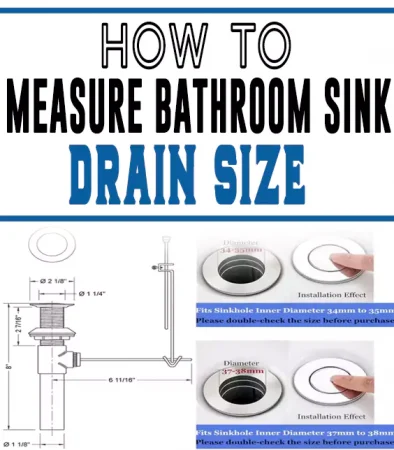When replacing the sink drain or whole bathroom sink, you need to know how to measure the bathroom sink drain size. Here’s how with a complete guide.
Securing a bathroom sink drain properly will save you from water spillage. You need to make sure the bathroom sink drain is fitted correctly to the plumbing system.
Bathroom sinks vary in design and size. For instance, the undermount sinks, vessel sinks, pedestal bathroom sinks, vanity sinks, wall-mounted sinks, console sinks, self-rimming sinks, etc. Each of these designs also has its respective drain size.
Taking the right measurement of a bathroom sink drain size is crucial so that you may get the right size bathroom sink drain that fits properly.
This guide has been put together to help you handle this task without a plumber’s assistance and extra cost.
How to Measure Bathroom Sink Drain Size

You will need some tools to measure the bathroom sink drain pipe diameter, which is equivalent to the sink drain size.
- Adjustable wrench
- Plumbing measuring tape or ruler
- Pliers
- Lubricant
The holes within the sink drain of bathroom sinks are usually small to prevent clogs or blockages. Its standard size is 1.25 inches. Other common sizes for drain openings are 1.5 and 1.625 inches.
Their job is to pass the water from the sink basin to the drainpipe. The drainpipe then leads to the drainage system, effectively getting rid of wastewater.
Step 1. Detach the sink drain pipe
You should begin by removing the pipe connected to the sink drain if it is already attached. You will get more accurate measurements by doing so.
Next, apply the lubricant to make it easy to remove, and use the adjustable wrench to detach the drain pipe from the drain hole outlet. This also helps you drain the water that the sink drain may be retaining.
Step 2. Hold the sink drain in place
Using the large adjustable wrench, hold the sink drain steady. Keeping the sink drain stable is crucial to getting accurate results.
Step 3. Measure the drain opening size
Measure the sink drain hole opening with the measuring tape. You will get the diameter of the drain pipe. Then, using a ruler, measure the bottom end of the drain.
Do this by inserting the ruler into the sink and taking the measurement from the straight edge. Write down the measurements so that you can remember them.
The steps listed above are explicitly explained to guide you through measuring your bathroom sink’s drain. Other important factors to consider include the sink position and material.
For sinks above the countertop, their drains should have a mounting ring. A mounting ring provides the sink with the needed support that a cabinet would give instead.
How to Measure Bathroom Sink Drain Pipes
The best way to measure a sink drain is by using a tape measure for accurate measurement. The tape measurement helps in getting the diameter accurately. The following steps should be followed on how to use the tape measure.
Step 1:
Use the tape measure to measure the distance between the house drain wall and the nut that secures the p-trap to the sink drain. Increase the measurement by 2 inches and write it down on paper. This measurement is for the sink drain pipe at the rear. The extra 2 inches is where the pipe slides into the drain in the wall of the house.
Step 2:
Put the tape measure over the nut that secures the drain pipe to the sink. bottom. It’s called an exhaust. Measure the nut that secures the p-trap to the exhaust pipe and record the measurement.
Step 3:
Place a measuring tape on the nut end securing the P-siphon to the drain pipe on the drain wall and measure the distance to the front of the p-trap. Again, record the measurements.
Step 4:
Move the tip of the tape measure over the water pipe connected to the faucet. Then measure the shutoff valve and record the measurements. Repeat this for the rest of the pipes.
Bathroom Sink Drain Sizes
The only function of a bathroom drain sink is to drain away from the sink. Sink drain sizes are nowadays standardized to achieve this and make switching drains easier. Various kinds of drains in different rooms of the home have varying sizes.
A bathroom sink drain is smaller than a kitchen sink drain. There is little need for a large drain hole because we only use it to wash hands, brush our teeth and shave.
Although some bathroom sinks may have drains pipes that connect to a one and a 1/4-inch tailpiece, most contemporary bathroom sink drains have a one and a 1/2-inch outlet.
All of the pipes that connect to the rear piece, along with the P-trap assembly and all lateral extensions, have a diameter of 1 1/4 or 1 1/2 inches. Wider drain pipes are recommended because they allow for a faster flow of water.
You can use an adapter to swap from a narrow drain pipe to a wider pipe amid the system.
What size PVC for bathroom sink drain?
The perfect way to determine the size of your drain is to read the manufacturing company manual as it contains the exact size as described. However, the standard sizes are 1 5/8 inches and 1.5 inches. A very common size people often use is 1/4 inches.
Conclusion
Bathroom sink is a vital part of any bathroom. It is, therefore, important that its components are installed appropriately. Wrong installations can cause leakages that can ruin your sink cabinet or, even worse, your bathroom.
The information in this guide will help you measure a bathroom sink drain. This guide has been carefully put together to help you select the right drain size for functionality and style.

